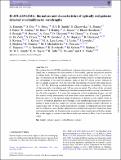H-ATLAS/GAMA : the nature and characteristics of optically red galaxies detected at submillimetre wavelengths
Abstract
We combine Herschel/SPIRE submillimetre (submm) observations with existing multiwavelength data to investigate the characteristics of low-redshift, optically red galaxies detected in submm bands. We select a sample of galaxies in the redshift range 0.01 ≤ z ≤ 0.2, having >5σ detections in the SPIRE 250 μm submm waveband. Sources are then divided into two sub-samples of red and blue galaxies, based on their UV-optical colours. Galaxies in the red sample account for ≈4.2 per cent of the total number of sources with stellar masses M* ≳ 1010 M⊙. Following visual classification of the red galaxies, we find that ≳30 per cent of them are early-type galaxies and ≳40 per cent are spirals. The colour of the red-spiral galaxies could be the result of their highly inclined orientation and/or a strong contribution of the old stellar population. It is found that irrespective of their morphological types, red and blue sources occupy environments with more or less similar densities (i.e. the Σ5 parameter). From the analysis of the spectral energy distributions of galaxies in our samples based on MAGPHYS, we find that galaxies in the red sample (of any morphological type) have dust masses similar to those in the blue sample (i.e. normal spiral/star-forming systems). However, in comparison to the red-spirals and in particular blue systems, red-ellipticals have lower mean dust-to-stellar mass ratios. Besides galaxies in the red-elliptical sample have much lower mean star formation/specific star formation rates in contrast to their counterparts in the blue sample. Our results support a scenario where dust in early-type systems is likely to be of an external origin.
Citation
Dariush , A , Dib , S , Hony , S , Smith , D J B , Zhukovska , S , Dunne , L , Eales , S , Andrae , E , Baes , M , Baldry , I , Bauer , A , Bland-Hawthorn , J , Brough , S , Bourne , N , Cava , A , Clements , D , Cluver , M , Cooray , A , De Zotti , G , Driver , S P , Grootes , M W , Hopkins , A M , Hopwood , R , Kaviraj , S , Kelvin , L , Lara-Lopez , M A , Liske , J , Loveday , J , Maddox , S , Madore , B , Michałowski , M J , Pearson , C , Popescu , C , Robotham , A , Rowlands , K E , Seibert , M , Shabani , F , Smith , M W L , Taylor , E N , Tuffs , R , Valiante , E & Virdee , J S 2016 , ' H-ATLAS/GAMA : the nature and characteristics of optically red galaxies detected at submillimetre wavelengths ' , Monthly Notices of the Royal Astronomical Society , vol. 456 , no. 2 , pp. 2221-2259 . https://doi.org/10.1093/mnras/stv2767
Publication
Monthly Notices of the Royal Astronomical Society
Status
Peer reviewed
ISSN
0035-8711Type
Journal article
Description
SD is supported by a Marie-Curie Intra European Fellowship under the European Community's Seventh Framework Programme FP7/2007-2013 grant agreement no. 627008. SH acknowledges support from the Deutsche Forschungsgemeinschaft (DFG) in the collaborative research project SFB881 The Milky Way System (subprojects B1). RJI, LD and SJM acknowledge support from the European Research Council Advanced Grant, cosmicism. SZ acknowledge support by the Deutsche Forschungsgemeinschaft through SPP 1573: Physics of the Interstellar Medium. GdZ acknowledge financial support from ASI/INAF Agreement 2014-024-R.0 for the Planck LFI activity of Phase E2. KR acknowledges support from the European Research Council Starting Grant SEDmorph (P.I: V. Wild).Collections
Items in the St Andrews Research Repository are protected by copyright, with all rights reserved, unless otherwise indicated.

